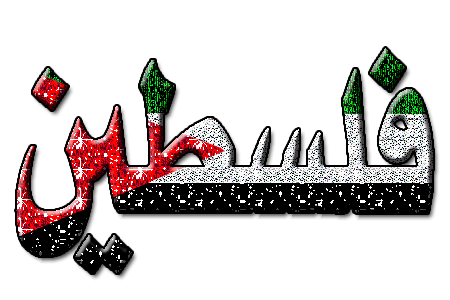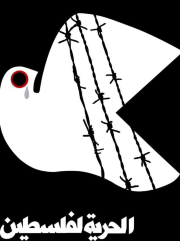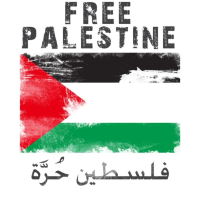Source(google.com.pk)
Free Palestine In Arabic Biography
The Palestinian people, (Arabic: الشعب الفلسطيني, ash-sha‘b al-Filasṭīnī) also referred to as Palestinians (Arabic: الفلسطينيون, al-Filasṭīniyyūn), are the modern descendants of people who have lived in Palestine over the centuries and today are largely culturally and linguistically Arab.[15][16][17][18][19][20][21][22][23] Despite various wars and exoduses, roughly one half of the world's Palestinian population continues to reside in the area encompassing the West Bank, the Gaza Strip, and Israel. In this combined area, as of 2004, Palestinians constituted 49% of all inhabitants,[24] encompassing the entire population of the Gaza Strip (1.6 million), the majority of the population of the West Bank (approximately 2.3 million versus close to 500,000 Jewish Israeli citizens which includes about 200,000 in East Jerusalem), and 16.5% of the population of Israel proper as Arab citizens of Israel.[4] Many are Palestinian refugees or internally displaced Palestinians, including more than a million in the Gaza Strip,[25] three-quarters of a million in the West Bank,[25] and about a quarter of a million in Israel proper. Of the Palestinian population who live abroad, known as the Palestinian diaspora, more than half are stateless lacking citizenship in any country.[26] About 2.6 million of the diaspora population live in neighboring Jordan where they make up approximately half the population,[27] 1.5 million live between Syria and Lebanon, a quarter of a million in Saudi Arabia, with Chile's half a million representing the largest concentration outside the Arab world.
Genetic analysis suggests that a majority of the Muslims of Palestine, inclusive of Arab citizens of Israel, are descendants of Christians, Jews and other earlier inhabitants of the southern Levant whose core may reach back to prehistoric times. A study of high-resolution haplotypes demonstrated that a substantial portion of Y chromosomes of Israeli Jews (70%) and of Palestinian Muslim Arabs (82%) belonged to the same chromosome pool.[28] Since the time of the Muslim conquests in the 7th century, religious conversions have resulted in Palestinians being predominantly Sunni Muslim by religious affiliation, though there is a significant Palestinian Christian minority of various Christian denominations, as well as Druze and a small Samaritan community. Though Palestinian Jews made up part of the population of Palestine prior to the creation of the State of Israel, few identify as "Palestinian" today. Acculturation, independent from conversion to Islam, resulted in Palestinians being linguistically and culturally Arab.[15] The vernacular of Palestinians, irrespective of religion, is the Palestinian dialect of Arabic. Many Arab citizens of Israel including Palestinians are bilingual and fluent in Hebrew.
The history of a distinct Palestinian national identity is a disputed issue amongst scholars.[29] Legal historian Assaf Likhovski states that the prevailing view is that Palestinian identity originated in the early decades of the twentieth century.[29] "Palestinian" was used to refer to the nationalist concept of a Palestinian people by the Arabs of Palestine in a limited way until World War I.[19][20] The first demand for national independence of the Levant was issued by the Syrian–Palestinian Congress on 21 September 1921.[30] After the creation of the State of Israel, the exodus of 1948, and more so after the exodus of 1967, the term came to signify not only a place of origin, but also the sense of a shared past and future in the form of a Palestinian state.[19] According to Rashid Khalidi, the modern Palestinian people now understand their identity as encompassing the heritage of all ages from biblical times up to the Ottoman period.[31]
Founded in 1964, the Palestine Liberation Organization (PLO) is an umbrella organization for groups that represent the Palestinian people before the international community.[32] The Palestinian National Authority, officially established as a result of the Oslo Accords, is an interim administrative body nominally responsible for governance in Palestinian population centers in the West Bank and Gaza Strip.The timing and causes behind the emergence of a distinctively Palestinian national consciousness among the Arabs of Palestine are matters of scholarly disagreement. Some argue that it can be traced as far back as the 1834 Arab revolt in Palestine (or even as early as the 17th century), while others argue that it didn't emerge until after the Mandate Palestine period.[29][49] According to legal historian Assaf Likhovski, the prevailing view is that Palestinian identity originated in the early decades of the twentieth century.[29]
In his 1997 book, Palestinian Identity: The Construction of Modern National Consciousness, historian Rashid Khalidi notes that the archaeological strata that denote the history of Palestine – encompassing the Biblical, Roman, Byzantine, Umayyad, Fatimid, Crusader, Ayyubid, Mamluk and Ottoman periods – form part of the identity of the modern-day Palestinian people, as they have come to understand it over the last century.[50] Noting that Palestinian identity has never been an exclusive one, with "Arabism, religion, and local loyalties" playing an important role, Khalidi cautions against the efforts of some Palestinian nationalists to "anachronistically" read back into history a nationalist consciousness that is in fact "relatively modern".[51][52]
Baruch Kimmerling and Joel S. Migdal consider the 1834 revolt of the Arabs in Palestine as constituting the first formative event of the Palestinian people. From 1516–1917, Palestine was ruled by the Ottoman Empire save a brief period In the 1830s when an Egyptian vassal of the Ottomans, Muhammad Ali, and his son Ibrahim Pasha asserted their own rule over the area. The revolt by Palestine's Arabs was precipitated by popular resistance against heavy demands for conscripts, with the peasants well aware that conscription was little more than a death sentence. Starting in May 1834 the rebels took many cities, among them Jerusalem, Hebron and Nablus and Ibrahim Pasha's army was deployed, defeating the last rebels on 4 August in Hebron.[53] Benny Morris argues that the Arabs in Palestine nevertheless remained part of a larger pan-Islamist or pan-Arab national movement.[54] Walid Khalidi argues otherwise, writing that Palestinians in Ottoman times were "[a]cutely aware of the distinctiveness of Palestinian history ..." and "[a]lthough proud of their Arab heritage and ancestry, the Palestinians considered themselves to be descended not only from Arab conquerors of the seventh century but also from indigenous peoples who had lived in the country since time immemorial, including the ancient Hebrews and the Canaanites before them."[55]
Rashid Khalidi argues that the modern national identity of Palestinians has its roots in nationalist discourses that emerged among the peoples of the Ottoman empire in the late 19th century that sharpened following the demarcation of modern nation-state boundaries in the Middle East after World War I.[51] Khalidi also states that although the challenge posed by Zionism played a role in shaping this identity, that "it is a serious mistake to suggest that Palestinian identity emerged mainly as a response to Zionism."[51] Conversely, historian James L. Gelvin argues that Palestinian nationalism was a direct reaction to Zionism. In his book The Israel-Palestine Conflict: One Hundred Years of War he states that "Palestinian nationalism emerged during the interwar period in response to Zionist immigration and settlement."[56] Gelvin argues that this fact does not make the Palestinian identity any less legitimate:










Free Palestine In Arabic Biography
The Palestinian people, (Arabic: الشعب الفلسطيني, ash-sha‘b al-Filasṭīnī) also referred to as Palestinians (Arabic: الفلسطينيون, al-Filasṭīniyyūn), are the modern descendants of people who have lived in Palestine over the centuries and today are largely culturally and linguistically Arab.[15][16][17][18][19][20][21][22][23] Despite various wars and exoduses, roughly one half of the world's Palestinian population continues to reside in the area encompassing the West Bank, the Gaza Strip, and Israel. In this combined area, as of 2004, Palestinians constituted 49% of all inhabitants,[24] encompassing the entire population of the Gaza Strip (1.6 million), the majority of the population of the West Bank (approximately 2.3 million versus close to 500,000 Jewish Israeli citizens which includes about 200,000 in East Jerusalem), and 16.5% of the population of Israel proper as Arab citizens of Israel.[4] Many are Palestinian refugees or internally displaced Palestinians, including more than a million in the Gaza Strip,[25] three-quarters of a million in the West Bank,[25] and about a quarter of a million in Israel proper. Of the Palestinian population who live abroad, known as the Palestinian diaspora, more than half are stateless lacking citizenship in any country.[26] About 2.6 million of the diaspora population live in neighboring Jordan where they make up approximately half the population,[27] 1.5 million live between Syria and Lebanon, a quarter of a million in Saudi Arabia, with Chile's half a million representing the largest concentration outside the Arab world.
Genetic analysis suggests that a majority of the Muslims of Palestine, inclusive of Arab citizens of Israel, are descendants of Christians, Jews and other earlier inhabitants of the southern Levant whose core may reach back to prehistoric times. A study of high-resolution haplotypes demonstrated that a substantial portion of Y chromosomes of Israeli Jews (70%) and of Palestinian Muslim Arabs (82%) belonged to the same chromosome pool.[28] Since the time of the Muslim conquests in the 7th century, religious conversions have resulted in Palestinians being predominantly Sunni Muslim by religious affiliation, though there is a significant Palestinian Christian minority of various Christian denominations, as well as Druze and a small Samaritan community. Though Palestinian Jews made up part of the population of Palestine prior to the creation of the State of Israel, few identify as "Palestinian" today. Acculturation, independent from conversion to Islam, resulted in Palestinians being linguistically and culturally Arab.[15] The vernacular of Palestinians, irrespective of religion, is the Palestinian dialect of Arabic. Many Arab citizens of Israel including Palestinians are bilingual and fluent in Hebrew.
The history of a distinct Palestinian national identity is a disputed issue amongst scholars.[29] Legal historian Assaf Likhovski states that the prevailing view is that Palestinian identity originated in the early decades of the twentieth century.[29] "Palestinian" was used to refer to the nationalist concept of a Palestinian people by the Arabs of Palestine in a limited way until World War I.[19][20] The first demand for national independence of the Levant was issued by the Syrian–Palestinian Congress on 21 September 1921.[30] After the creation of the State of Israel, the exodus of 1948, and more so after the exodus of 1967, the term came to signify not only a place of origin, but also the sense of a shared past and future in the form of a Palestinian state.[19] According to Rashid Khalidi, the modern Palestinian people now understand their identity as encompassing the heritage of all ages from biblical times up to the Ottoman period.[31]
Founded in 1964, the Palestine Liberation Organization (PLO) is an umbrella organization for groups that represent the Palestinian people before the international community.[32] The Palestinian National Authority, officially established as a result of the Oslo Accords, is an interim administrative body nominally responsible for governance in Palestinian population centers in the West Bank and Gaza Strip.The timing and causes behind the emergence of a distinctively Palestinian national consciousness among the Arabs of Palestine are matters of scholarly disagreement. Some argue that it can be traced as far back as the 1834 Arab revolt in Palestine (or even as early as the 17th century), while others argue that it didn't emerge until after the Mandate Palestine period.[29][49] According to legal historian Assaf Likhovski, the prevailing view is that Palestinian identity originated in the early decades of the twentieth century.[29]
In his 1997 book, Palestinian Identity: The Construction of Modern National Consciousness, historian Rashid Khalidi notes that the archaeological strata that denote the history of Palestine – encompassing the Biblical, Roman, Byzantine, Umayyad, Fatimid, Crusader, Ayyubid, Mamluk and Ottoman periods – form part of the identity of the modern-day Palestinian people, as they have come to understand it over the last century.[50] Noting that Palestinian identity has never been an exclusive one, with "Arabism, religion, and local loyalties" playing an important role, Khalidi cautions against the efforts of some Palestinian nationalists to "anachronistically" read back into history a nationalist consciousness that is in fact "relatively modern".[51][52]
Baruch Kimmerling and Joel S. Migdal consider the 1834 revolt of the Arabs in Palestine as constituting the first formative event of the Palestinian people. From 1516–1917, Palestine was ruled by the Ottoman Empire save a brief period In the 1830s when an Egyptian vassal of the Ottomans, Muhammad Ali, and his son Ibrahim Pasha asserted their own rule over the area. The revolt by Palestine's Arabs was precipitated by popular resistance against heavy demands for conscripts, with the peasants well aware that conscription was little more than a death sentence. Starting in May 1834 the rebels took many cities, among them Jerusalem, Hebron and Nablus and Ibrahim Pasha's army was deployed, defeating the last rebels on 4 August in Hebron.[53] Benny Morris argues that the Arabs in Palestine nevertheless remained part of a larger pan-Islamist or pan-Arab national movement.[54] Walid Khalidi argues otherwise, writing that Palestinians in Ottoman times were "[a]cutely aware of the distinctiveness of Palestinian history ..." and "[a]lthough proud of their Arab heritage and ancestry, the Palestinians considered themselves to be descended not only from Arab conquerors of the seventh century but also from indigenous peoples who had lived in the country since time immemorial, including the ancient Hebrews and the Canaanites before them."[55]
Rashid Khalidi argues that the modern national identity of Palestinians has its roots in nationalist discourses that emerged among the peoples of the Ottoman empire in the late 19th century that sharpened following the demarcation of modern nation-state boundaries in the Middle East after World War I.[51] Khalidi also states that although the challenge posed by Zionism played a role in shaping this identity, that "it is a serious mistake to suggest that Palestinian identity emerged mainly as a response to Zionism."[51] Conversely, historian James L. Gelvin argues that Palestinian nationalism was a direct reaction to Zionism. In his book The Israel-Palestine Conflict: One Hundred Years of War he states that "Palestinian nationalism emerged during the interwar period in response to Zionist immigration and settlement."[56] Gelvin argues that this fact does not make the Palestinian identity any less legitimate:
Free Palestine In Arabic
Free Palestine In Arabic

Free Palestine In Arabic

Free Palestine In Arabic

Free Palestine In Arabic

Free Palestine In Arabic

Free Palestine In Arabic

Free Palestine In Arabic

Free Palestine In Arabic

Free Palestine In Arabic

Free Palestine In Arabic
am trying to obtain the wristbands(not listed above) which have the Palestinian flag...a little larger than the ones illustrated...would you know were we could purchase these ? many thanks. p.s. they do exist as we have seen them.
ReplyDelete